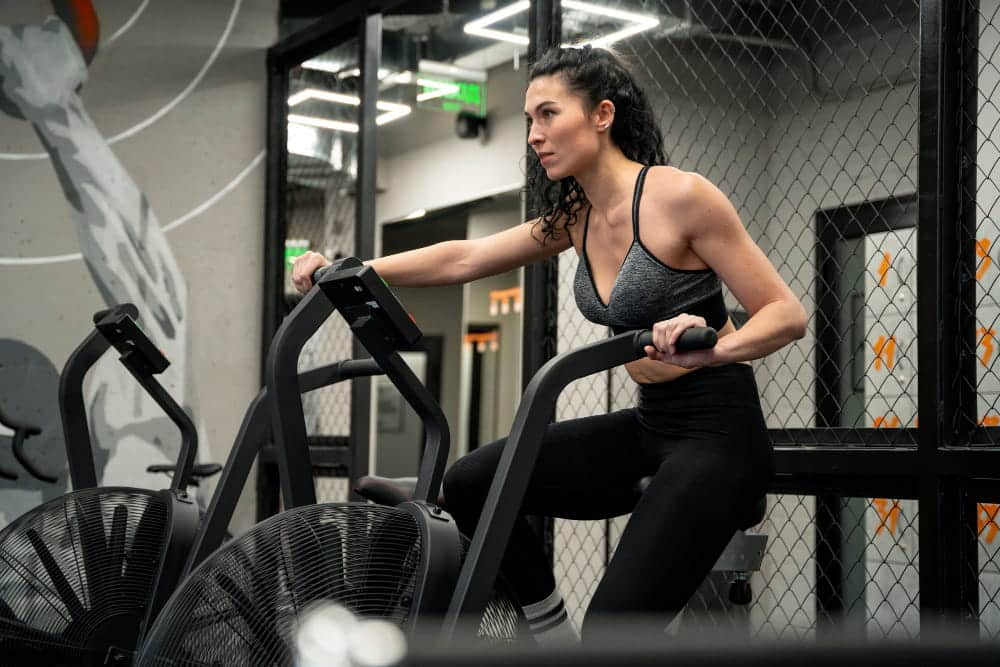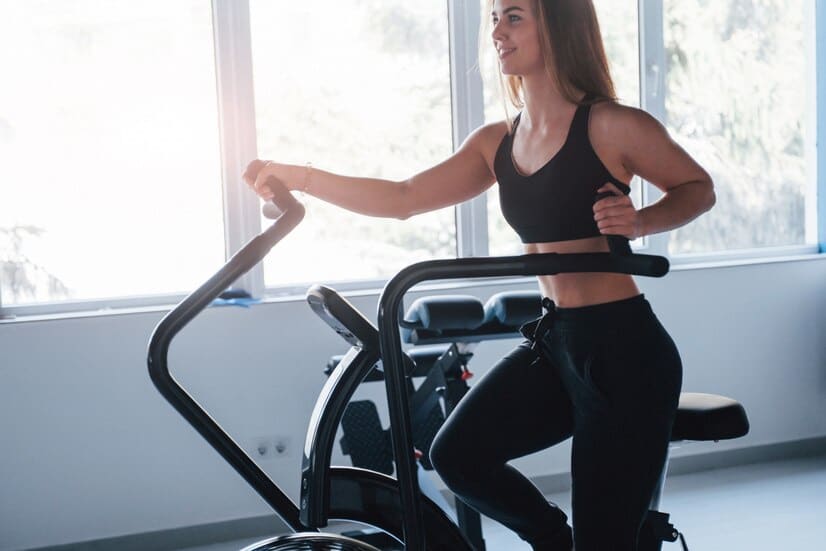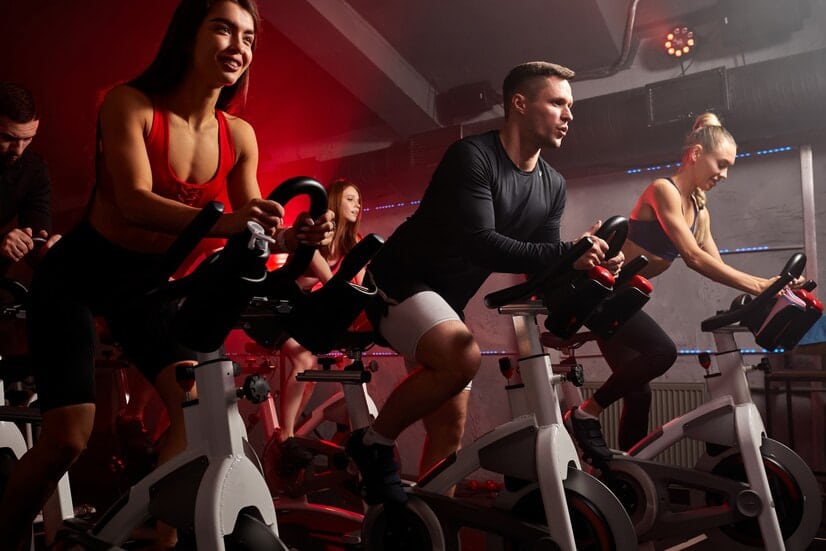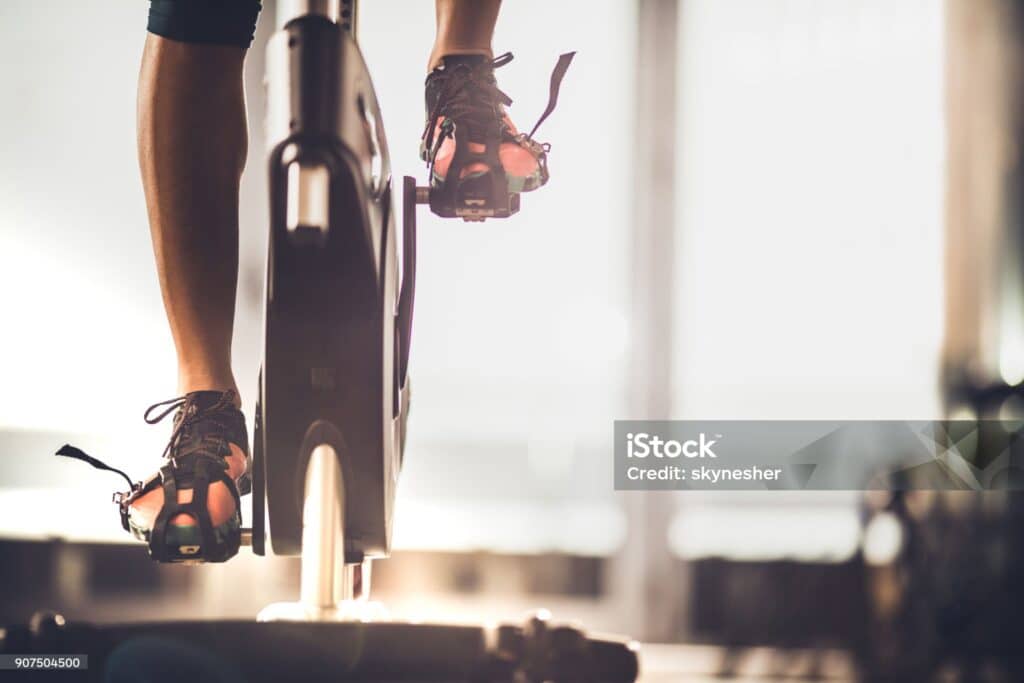
Summary
Welcome » Welcome » Tips for getting started » Different types of gym bikes: find the one you need for training
Different types of gym bikes: find the one you need for training
Are you looking for the ideal exercise bike to achieve your fitness goals? Whether you want to lose weight, improve your endurance or strengthen your muscles, this article will guide you in your choice. Discover the different types of bikes and their advantages.
Summary
The different types of exercise bikes
Each different type of gym bike has specific features suited to various goals. We detail upright, recumbent, semi-recumbent and elliptical bikes. You will also learn how to choose your bike according to your needs.
When it comes to choosing an indoor bike for your apartment, it's essential to know the different options available. Here's an overview of the main types of indoor bikes and their distinctive features.
Upright bikes
Upright bikes, also called upright bikes, are most common in gyms. They are distinguished by their structure similar to that of traditional road bikes. You pedal in an upright position, which mainly uses the muscles of your legs and lower body. Their compact design makes them ideal for tight spaces, but they may be less comfortable over long sessions due to the more rigid seating position.
Recumbent bikes
Recumbent bikes, or recumbent bikes, offer a different pedaling position, with your back supported and legs extended forward. This type of bike is perfect for those looking to minimize strain on the back and joints. The wider seat and backrest provide increased comfort, allowing for longer and more relaxing sessions. However, their larger size can pose a space problem in small spaces.
Semi-recumbent bikes
Recumbent bikes represent a compromise between upright and recumbent bikes. They offer a slightly inclined pedaling position, reducing pressure on the back while maintaining a certain compactness. This type of bike is suitable for those looking for a good balance between comfort and size. They allow for long workouts without sacrificing too much space in your interior.
Elliptical bikes
Elliptical trainers, although a little different from traditional bikes, deserve their place on this list. They combine the movements of cycling, walking and cross-country skiing, providing a full-body workout. In addition to working the legs, they also work the arms, core and other muscle groups. Their fluid, natural movement reduces impact on joints, making them an ideal choice for those looking to vary their workouts while taking care of their body. However, they can be more bulky and expensive than other types of exercise bikes.
By choosing the type of exercise bike that best fits your needs and space constraints, you can optimize your workout and achieve your fitness goals more efficiently.
Advantages and disadvantages of each type of bicycle
When it comes to choosing the ideal exercise bike, it's crucial to weigh the pros and cons of each type to make an informed decision. Here is a detailed analysis to help you.
Upright bikes
Benefits :
- Compactness: Upright bikes are often more compact, making them perfect for smaller spaces.
- Ease of use : Their simple, intuitive design is suitable for all experience levels.
- Affordable cost: In general, upright bikes are less expensive than other types of exercise bikes.
Disadvantages:
- Limited comfort: The upright position can become uncomfortable during long sessions, causing back and neck pain.
- Less support: The lack of a backrest can be a disadvantage for those with back problems.
Recumbent bikes
Benefits :
- Maximum comfort: The wide seat and back support the back, allowing prolonged sessions without discomfort.
- Reduction of constraints: The lying position minimizes pressure on the joints, ideal for people with knee or back problems.
- Stability: The wider base provides increased stability, reducing the risk of tipping.
Disadvantages:
- Dimensions: These bikes take up more space, which can be a problem in tight spaces.
- High price : They tend to be more expensive due to their design and functionality.
Semi-recumbent bikes
Benefits :
- Balanced compromise: They offer a good balance between comfort and compactness, with a semi-reclined seat.
- Versatility: Suitable for a variety of users, from beginners to advanced athletes.
- Reasonable comfort: Less restrictive on the back than upright bikes, while being more compact than recumbent bikes.
Disadvantages:
- Lower comfort than recumbent bikes: Although more comfortable than upright bikes, they do not surpass the comfort of recumbent bikes.
- Average stability: Their stability may vary depending on the model, and they may be less stable than recumbent bikes.
Elliptical bikes
Benefits :
- Natural movement: Elliptical trainers mimic the natural movements of walking, cycling and cross-country skiing, reducing stress on joints.
- Complete training: They work multiple muscle groups, providing simultaneous cardio and strength training.
- Low impact: Ideal for those looking to minimize impact on joints while training intensely.
Disadvantages:
- Significant bulk: Their size can be a problem in small spaces.
- High cost : Because of their complexity and the benefits they offer, elliptical trainers tend to be more expensive.
- Learning curve: They may require some adaptation time to master the elliptical movement.
By carefully weighing these pros and cons, you can choose the exercise bike that best meets your needs, space constraints, and fitness goals.

How to choose your bike according to your objectives?
Choosing an exercise bike should be guided by your fitness goals. Each type of bike offers specific benefits depending on what you want to accomplish. Here's how to choose yours according to your goals.
Weightloss
Upright or elliptical bikes are ideal for burning calories efficiently.
- Upright bike: The intensity of training on an upright bike helps increase your heart rate quickly, promoting fat burning. Their compactness allows frequent sessions even in a limited space.
- Elliptical bike: It offers a full-body workout, burning more calories by engaging multiple muscle groups. Its low impact on the joints allows prolonged sessions without risk of injury.
Endurance
To improve your endurance, recumbent bikes are your best choice.
- Recumbent bike: The comfortable position allows you to carry out longer sessions without feeling discomfort. This allows you to work on your cardiovascular endurance over extended periods, crucial for developing good physical resistance.
Muscle strengthening
Elliptical bikes are perfect for complete muscle work.
- Elliptical bike: In addition to the legs, it engages the arms, back and core. This multiple request promotes balanced muscle strengthening. The adjustable resistance allows you to intensify the effort and target different muscle groups, increasing strength and muscle mass.
Rehabilitation
For gentle rehabilitation, opt for semi-recumbent bikes.
- Semi-recumbent bike : It offers a semi-reclined position that reduces pressure on joints and back, while providing an effective cardiovascular workout. It is an excellent choice for those recovering from an injury or who have physical limitations, thanks to its design that combines comfort and stability.
Choose based on your goals
Choosing the right exercise bike depends on what you aim to accomplish. For weight loss, upright or elliptical trainers are ideal. If your goal is to build endurance, recumbent bikes provide the comfort needed for long sessions. For balanced muscle strengthening, elliptical bikes are the most suitable. Finally, for rehabilitation, recumbent bikes offer a perfect compromise between comfort and efficiency. Identify your goals to choose the bike that will help you achieve them optimally.
Specificities of stationary bikes
Stationary bikes, or exercise bikes, are popular equipment for home workouts. They have several specific features that make them unique. Here's a detailed overview of their pros and cons.
Compact
- Space saving: Stationary bikes are designed to be space-saving, making them ideal for apartments or small spaces. You can easily place them in a bedroom, living room, or even a corner of your home office.
- Mobility: Some models are equipped with casters, making them easier to move and store after use.
Cheap
- Accessibility: Compared to other fitness equipment, stationary bikes are often more affordable. They are a great entry point for those who want to start working out at home without investing a significant amount of money.
- Reduced maintenance: With fewer moving parts and a simple design, stationary bikes generally require less maintenance, reducing costs in the long run.
Easy to use
- Intuitive: The simplicity of their design makes them easy to use, even for beginners. You don't need any special technical skills to start your workout.
- Simple settings: THE resistance settings, saddle and handlebars are often easy to adjust, allowing each user to personalize their training according to their needs.
Disadvantages
- Rigid position: Stationary bikes offer less support for the back and can become uncomfortable during prolonged sessions. Sitting upright can cause strain in your lower back and glutes after prolonged use.
- Hard saddle: Many models have a harder, less padded saddle, which can cause pain and numbness during long training sessions.
- Limited customization: Compared to other types of exercise bikes, stationary bikes often offer fewer adjustment options for resistance and seat and handlebar position. This can limit your ability to fit the bike perfectly to your body shape.
- Restricted features: Basic models may lack advanced features like built-in workout programs, heart rate monitors, or Bluetooth connectivity for fitness apps.
Specificities of elliptical bikes
Elliptical trainers are versatile and complete equipment, ideal for overall training. Here is a detailed analysis of their advantages and disadvantages.
Benefits
- Imitation of walking and cross-country skiing: The elliptical movement reproduces natural movements such as walking, running or cross-country skiing. This allows for a smooth and comfortable transition, reducing the risk of injury.
- Fluid and continuous: The elliptical path of the pedals provides continuous exercise without shock, which is ideal for sensitive joints.
- Complete training: Unlike traditional bikes, elliptical bikes work the legs, arms, back and trunk simultaneously. By using the moving handles, you also engage your upper body, making the workout more complete and balanced.
- Muscle strengthening: The different resistances and programs available allow you to target and strengthen various muscle groups, thus increasing the effectiveness of each session.
- Joint protection: With its gentle, non-impact movement, the elliptical trainer is perfect for those suffering from joint pain or looking to prevent injuries. It offers a great way to exercise safely.
- Ideal for rehabilitation: People in rehabilitation or recovery can benefit from using an elliptical trainer to improve their fitness without stressing their joints.
Disadvantages
- Space required: Elliptical bikes have a wider and longer frame, requiring more space than stationary or upright bikes. They can be difficult to install in small apartments or already cluttered spaces.
- Difficult to move: Due to their size and weight, these devices are often less portable. This can be a problem if you need to move them frequently.
- High initial investment: Elliptical trainers are generally more expensive than other types of exercise bikes. This initial investment can be a barrier for some users.
- Maintenance and repairs: With more moving parts and complex electronic systems, elliptical trainers may require more maintenance and result in higher repair costs.
Tips for choosing the right bike
Choosing the ideal exercise bike can seem complicated with all the options available. Here are some practical tips to help you make the best choice based on your needs and constraints.
Try different models in store
- Comfort and fit: Going to the store to try out different models is crucial. Sit on each type of bike, adjust the saddle and handlebars, and test the resistance. A comfortable, well-fitting bike will encourage you to use it regularly.
- Pedaling sensations: Each model offers a different feel. Try several bikes to find the one that feels most natural and enjoyable to you.
Measure your height and weight to fit the bike
- Proper sizing: Your height and weight strongly influence the choice of bike. Make sure the model you choose can support your weight and offers adjustments for your body type.
- Stability and robustness: Choose a bike with a solid and stable structure, especially if you are tall or of strong build. This ensures safe and durable use.
Check the settings
- Saddle and handlebar adjustments: A good exercise bike should allow precise adjustments of the saddle and handlebars to adapt to your body shape. Correct posture minimizes the risk of pain and injury.
- Resistance Levels: Opt for a model with several resistance levels. This allows you to progress and vary your workouts, thereby increasing your endurance and strength.
- Flywheel: The flywheel is a key element for smooth and regular pedaling. A flywheel of at least 8 kg provides better stability and a more natural pedaling feel.
- Fluidity of movement: A heavier flywheel ensures stable and smooth resistance, making training more enjoyable and effective.
Examples of exercise bike workouts
Varying your exercise bike workouts is essential to maintain your motivation and achieve your fitness goals. Here are some examples of effective workouts you can try.
Intervals
- Principle: Alternate periods of intense sprints with recovery phases. For example, 30 seconds of sprinting followed by 90 seconds of recovery.
- Benefits: Improves cardiovascular fitness, burns more calories in less time and increases endurance. Ideal for those who want to lose weight quickly and effectively.
- Duration : 20 to 30 minutes is enough for an effective workout. You can adjust the intensity and duration of intervals based on your fitness level.
Endurance
- Principle: Cycle at a moderate, steady pace over an extended period of time, usually between 45 minutes and an hour.
- Benefits: Increases cardiovascular and muscular endurance, improves resistance to fatigue. Perfect for cyclists and long distance enthusiasts.
- Pace : Maintain a stable heart rate, usually around 60-70% of your maximum heart rate. The goal is to be able to hold a conversation while pedaling.
Split
- Principle: similar to interval training, but with medium intensity work phases and active recovery periods. For example, 2 minutes at a moderate intensity followed by 1 minute of light pedaling.
- Benefits: Improves aerobic and anaerobic capacity, and allows faster recovery. Ideal for those who want to improve their overall performance.
- Duration : approximately 30 to 40 minutes, with several work and recovery cycles.
Bodybuilding
- Principle: Use high resistance and pedal at a slow cadence, usually between 50 and 60 RPM (revolutions per minute on a bike).
- Benefits: Strengthens leg and lower body muscles, including quads, hamstrings and calves. Useful for those who want to develop muscle strength.
- Repetitions: Perform sessions of 10 to 15 minutes, with breaks between each high-resistance set to avoid excessive fatigue.

Conclusion
Choosing the right exercise bike depends on your goals. To lose weight, improve your endurance or strengthen your muscles, each type of bike has its advantages. Upright, recumbent, semi-recumbent and elliptical bikes meet specific needs.
Consider testing different models in store. Adjust the saddle and handlebars for optimal comfort. Vary your workouts for maximum results.
Qu’importe votre choix, vous saurez profiter des bienfaits du vélo d’appartement !
Strengthen your legs with Space Cycle
Do you want to combine cycling and bodybuilding? At SPACE CYCLE, our POWER RIDE class mixes cardio and strengthening for a complete workout, targeting the “core”.
With SPACE CYCLE, immerse yourself in a unique immersive experience with light shows and a supercharged atmosphere, led by our coaches and their exclusive playlists.
Join us in our Bonne Nouvelle or Bastille studios for unrivaled indoor cycling sessions!
Read also
RPM combien de fois par semaine : Guide pour optimiser vos séances
Vélo d’appartement bienfaits : pourquoi l’adopter dès maintenant ?
Follow us
on instagram
To follow all our news,
take advantage of our tutorials and participate
in our many contests.
Breaking news!
Receive our newsletter.





